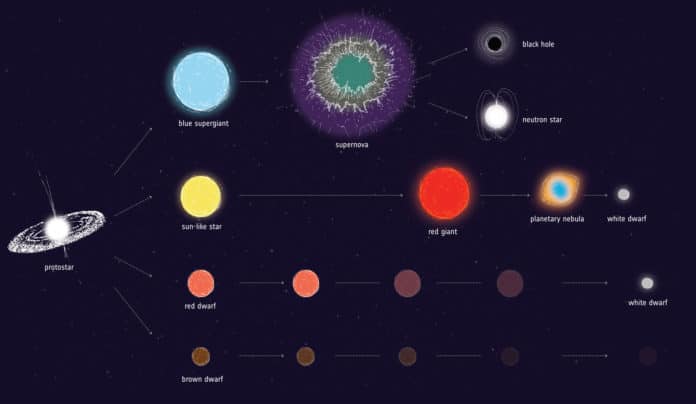By identifying stars of similar mass and composition, astronomers can see how our Sun is going to evolve in the future. All credit goes to ESA‘s star mapping Gaia mission.
The database from Gaia’s third major data release (DR3) revealed the intrinsic properties of hundreds of millions of stars, including how hot they are, how big they are, and what masses they contain.
At the time, astronomers focused on categorizing the appearance of “spectral lines.” These black lines can be seen in the prism-split rainbow of colors that results from a star.
The stars were arranged in a spectral classification sequence based on the intensity of these spectral lines. The temperature of the stars was later discovered to be directly correlated with this arrangement. A distinct classification was created based on the width of specific spectral lines. This was eventually found to be connected to a star’s brilliance and age.
These two characteristics can be connected to plot every star in the Universe on a single diagram. It has come to be known as the Hertzsprung-Russell (HR) diagram and is one of the pillars of astrophysics. An HR diagram displays a star’s intrinsic brightness against its effective surface temperature. By doing this, it demonstrates how stars change throughout the course of their long lives.
While the mass of the star changes relatively little during its lifetime, the star’s temperature and size vary significantly as it ages. These changes are driven by the type of nuclear fusion reactions that occur inside the lead at the time.
Credit: ESA/Gaia/DPAC, CC BY-SA 3.0 IGO
Astronomers combed the data looking for the most accurate stellar observations that the spacecraft could offer.
Orlagh Creevey, Observatoire de la Côte d’Azur, France, said, “We wanted to have a pure sample of stars with high precision measurements.”
They mainly focused on stars with surface temperatures of between 3000K and 10 000K because these are the longest-lived stars in the Galaxy and hence can reveal the history of the Milky Way. Plus, these stars are promising candidates for finding exoplanets because they are broadly similar to the Sun, which has a surface temperature of 6000K.
Next, astronomers filtered the sample only to show those stars with the same mass and chemical composition as the Sun. Since they allowed the age to be different, the stars they selected ended up tracing out a line across the H-R diagram representing our Sun’s evolution from its past into its future. It revealed how our star would vary its temperature and luminosity as it ages.
It is evident from this analysis that our Sun will achieve its peak temperature at roughly 8 billion years of age, after which it will cool and enlarge, turning into a red giant star at around 10–11 billion years old. After this stage, the Sun will approach the end of its existence when it eventually transforms into a dim white dwarf.
Credit: ESA/Gaia/DPAC
Orlagh said, “Finding stars similar to the Sun is essential for understanding how we fit into the wider Universe. If we don’t understand our own Sun – and there are many things we don’t know about it – how can we expect to understand all of the other stars that make up our wonderful Galaxy.”
“It is a source of some irony that the Sun is our nearest, most studied star, yet its proximity forces us to study it with completely different telescopes and instruments from those that we use to look at the rest of the stars. This is because the Sun is so much brighter than the other stars. We can bridge this observational gap by identifying similar stars to the Sun, but this time with similar ages.”
Scientists identified solar analogs in the Gaia data by looking for stars with temperatures, surface gravities, compositions, masses, and radii that are all similar to the present-day Sun. They found 5863 stars that matched their criteria.
Gaia has now created the target list, allowing others to dig deeper into them. They want to know, among other things, if all solar analogs have planetary systems that are comparable to our own. Do all solar analogs revolve at the same speed as the Sun?
Orlagh said, “With data release 3, Gaia’s supremely accurate instrumentation has allowed the stellar parameters of more stars to be determined more precisely than ever before. And that accuracy will ripple out to many other studies, For example, knowing stars more accurately can help when studying galaxies, whose light is the amalgamation of billions of individual stars.”
“The Gaia mission has touched everywhere in astrophysics.”
“So, almost certainly, it will not only be the Sun’s past and future that this work helps illuminate.”
